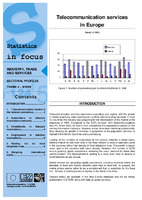Statistics in Focus. Telecommunication services in Europe.

Working Document
Author
EU Commission
Date
1999-03-11View/
Subject headings
Statistics ; Industrial Policy ; TelecommunicationsAbstract
Telecommunication services have been expanding very rapidly, with the growth in mobile telephony, data transmission, and the internet fuelling demand. In most EU countries the industry was preparing for the liberalisation of the market at the beginning of 1998. Compared to the GDP, turnover from telecommunications was 2%, which does not seem much considering the expectations placed on the coming information highways. However prices have been declining substantially, thus reducing the growth in turnover. In proportion to the population, turnover is highest in the Nordic Countries and Luxembourg. Looking at the numbers of subscribers to the various networks it would seem, that the market for new main lines in the fixed network is close to saturation point in the countries with a high density of fixed telephone lines. The growth is clearly more rapid in the countries with lower density. However, the number of ISDN lines is growing rapidly everywhere, reflecting the users’ demand for faster data
communication. The development is leading to a more even level of density of fixed networks across Europe. Mobile phones are spreading rapidly everywhere, including countries where the densities of fixed and mobile networks were high to start with. At present, the mobile phone seems rather to be a complement than a substitute for the fixed line. Density of mobile phones is highest in the Nordic Countries. Detailed tables are available in the New Cronos database and will be shortly CA published on CD-ROM, along with data on postal services.
